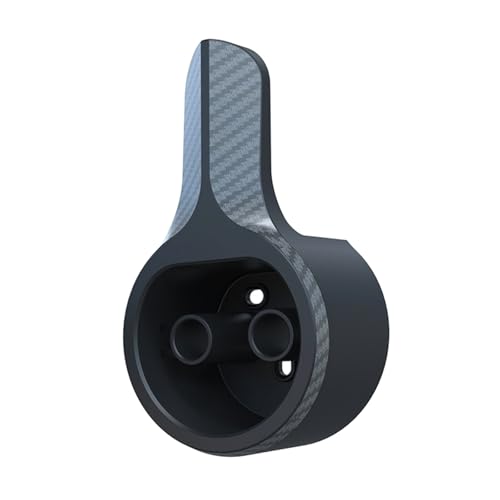You are using an out of date browser. It may not display this or other websites correctly.
You should upgrade or use an alternative browser.
You should upgrade or use an alternative browser.
Analysis of a replacement battery.
- Thread starter JejuSoul
- Start date

Help Support Kia Soul EV Forum:
This site may earn a commission from merchant affiliate
links, including eBay, Amazon, and others.
-
Just looked at the charging profile of my replacement battery for the first time.
I don't charge to 100% very often and hadn't plotted this data before.
(Edit - I do have a similar plot from March 9th 2020. That one doesn't have this oddity.)
This is a 28.8A charge from 40% SOC to 100% SOC.
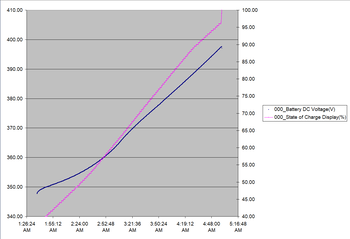
The battery is fully charged at 96.5% SOC. The last 3.5% of displayed SOC didn't add anything into the battery.
The BMS for a 27kWh car is built for the old battery cells, clearly it doesn't work correctly with the newer higher capacity cells.
They told me the BMS had been upgraded to cope, but is not working in this real example.
Edit (2 years later) I think this jump in SOC is purely because I don't charge to 100% very often and the BMS doesn't know where 100% will be.
It has nothing to do with the new BMS.
Note the energy added is equivalent to a battery capacity of 30.4kWh. It was fully charged. I haven't 'lost' anything.
The final resting voltage at 100% SOC is 397.1V
My other car a 27kWh with SOH = 96% has a final resting voltage at 100% SOC of 398.0V
The voltages are the same, the difference is that the old cells are 37.5Ah, the new cells are 40.0Ah.
(Parallel cell pairs will have 75.0Ah, and 80.0Ah.)
Also of note - a MY2018 30kWh Soul EV has a final resting voltage at 100% SOC of 410.0V
This has 100 cells, each charged to 4.10V
My car has 96 cells, each charged to 4.14V
I assume this means there is a much larger buffer on the MY2018 30kWh Soul EV than a MY2015 replacement battery 30kWh Soul EV.
-
Just looked at the charging profile of my replacement battery for the first time.
I don't charge to 100% very often and hadn't plotted this data before.
(Edit - I do have a similar plot from March 9th 2020. That one doesn't have this oddity.)
This is a 28.8A charge from 40% SOC to 100% SOC.

The battery is fully charged at 96.5% SOC. The last 3.5% of displayed SOC didn't add anything into the battery.
The BMS for a 27kWh car is built for the old battery cells, clearly it doesn't work correctly with the newer higher capacity cells.
They told me the BMS had been upgraded to cope, but is not working in this real example.
Edit (2 years later) I think this jump in SOC is purely because I don't charge to 100% very often and the BMS doesn't know where 100% will be.
It has nothing to do with the new BMS.
Note the energy added is equivalent to a battery capacity of 30.4kWh. It was fully charged. I haven't 'lost' anything.
The final resting voltage at 100% SOC is 397.1V
My other car a 27kWh with SOH = 96% has a final resting voltage at 100% SOC of 398.0V
The voltages are the same, the difference is that the old cells are 37.5Ah, the new cells are 40.0Ah.
(Parallel cell pairs will have 75.0Ah, and 80.0Ah.)
Also of note - a MY2018 30kWh Soul EV has a final resting voltage at 100% SOC of 410.0V
This has 100 cells, each charged to 4.10V
My car has 96 cells, each charged to 4.14V
I assume this means there is a much larger buffer on the MY2018 30kWh Soul EV than a MY2015 replacement battery 30kWh Soul EV.
-
Thanks for the info. I bought a "KONNWEI KW902 Mini BT Wireless OBD-II" - surprisingly inexpensive - the red one was less than $6 on Amazon, and then purchased Soul EV Spy app (Android only, as you said), and it worked great!
It told me I have 63% SOH (State of Health) - below the 70% warranty level. So, I have opened a ticket at Kia Customer Support website for battery replacement. At least, it's the start of probably a long process, as I'm in NC and nearest "qualified EV" Kia dealer is hundreds of miles away.
It told me I have 63% SOH (State of Health) - below the 70% warranty level. So, I have opened a ticket at Kia Customer Support website for battery replacement. At least, it's the start of probably a long process, as I'm in NC and nearest "qualified EV" Kia dealer is hundreds of miles away.
-
My replacement battery has now done 10,000km in ten months.
It is doing very well. It has lost 0.1% of capacity.
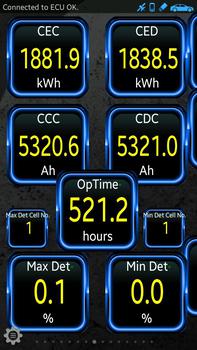
This is better than any other car we have data for.
Previous record holders were Elmil in Sweden, and SoulEV2016 in France. They both charged at 10A (~2kWh).
I always charge at 32A (~6kWh).
My assumption now is that the newer E400 cell not only has higher capacity but also degrades slower than the original E375.
This fits with the lack of data we have have from any 30kWh Soul EVs with degradation.
-
Here is a list of the various ROM-IDs for each of the BMS Firmware updates on the original Soul EV.
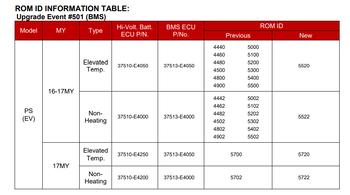
This is badly translated from the Korean as is so often the case with Hyundai / Kia.
E4050 - 'Elevated Temp' actually means with Battery Heater.
E4000 - 'Non-Heating' means without Battery Heater.
My replacement battery is an E4200 - It has the new cells and no Battery Heater. I must have version 5702 BMS firmware.
MY17 in the lower section should be MY18 to match the actual pack I got.
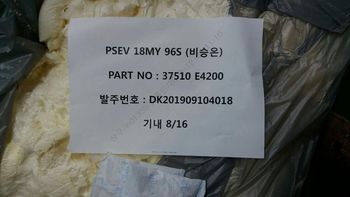
-
-
My replacement battery has now done 10,000km in ten months.
It is doing very well. It has lost 0.1% of capacity.

This is better than any other car we have data for.
Previous record holders were Elmil in Sweden, and SoulEV2016 in France. They both charged at 10A (~2kWh).
I always charge at 32A (~6kWh).
My assumption now is that the newer E400 cell not only has higher capacity but also degrades slower than the original E375.
This fits with the lack of data we have have from any 30kWh Soul EVs with degradation.
-
Here is a list of the various ROM-IDs for each of the BMS Firmware updates on the original Soul EV.

This is badly translated from the Korean as is so often the case with Hyundai / Kia.
E4050 - 'Elevated Temp' actually means with Battery Heater.
E4000 - 'Non-Heating' means without Battery Heater.
My replacement battery is an E4200 - It has the new cells and no Battery Heater. I must have version 5702 BMS firmware.
MY17 in the lower section should be MY18 to match the actual pack I got.

-
-
-
After 1 year and 12,500km the replacement battery is still doing really well.
Still 0.1% deterioration loss.
Here's the winter range at 7C. 197km is also the winter range as measured last March when the battery was new.
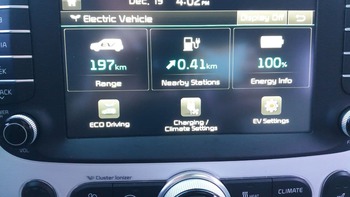
----------------------------
The only issue with the car this year was yesterday. I left the car idle for 5 days during the Winter Holidays and the 12V battery died.
I am not the first to have this happen.
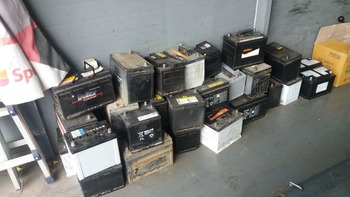
After 1 year and 12,500km the replacement battery is still doing really well.
Still 0.1% deterioration loss.
Here's the winter range at 7C. 197km is also the winter range as measured last March when the battery was new.

----------------------------
The only issue with the car this year was yesterday. I left the car idle for 5 days during the Winter Holidays and the 12V battery died.
I am not the first to have this happen.

-
After 1 year 4 months and 17,250km the replacement battery is still doing really well.
Still 0.1% deterioration loss. (Is this possible? Have they changed the way the BMS works?)
Here are the results of my latest range test and calibration.
I charged up to 100%, drove down to 7% and then charged back up to 100% SOC.
I stopped driving at 7% when the display changed to '---' for the remaining distance.
Just before this happened the display was showing 14km left.
The odometer shows I had driven 226km, Hence I will estimate that I could have driven 240km until the car turtled at 0%
The simple method for calculating the usable capacity is to divide the range by the the consumption.
In this case the numbers are easy. 240 km / 8.0 km/kWh = 30 kWh
I used Torque to gain more accurate data from the battery system itself and will post this next.
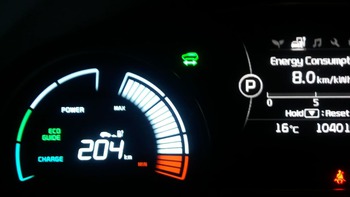
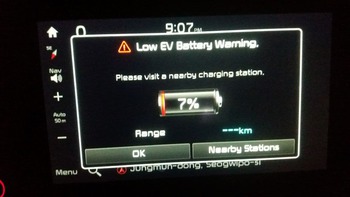
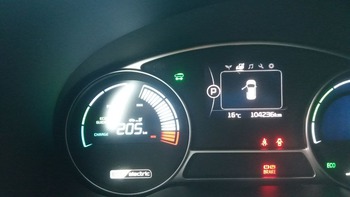
After 1 year 4 months and 17,250km the replacement battery is still doing really well.
Still 0.1% deterioration loss. (Is this possible? Have they changed the way the BMS works?)
Here are the results of my latest range test and calibration.
I charged up to 100%, drove down to 7% and then charged back up to 100% SOC.
I stopped driving at 7% when the display changed to '---' for the remaining distance.
Just before this happened the display was showing 14km left.
The odometer shows I had driven 226km, Hence I will estimate that I could have driven 240km until the car turtled at 0%
The simple method for calculating the usable capacity is to divide the range by the the consumption.
In this case the numbers are easy. 240 km / 8.0 km/kWh = 30 kWh
I used Torque to gain more accurate data from the battery system itself and will post this next.




$61.19
$69.99
ACDelco ARW1209P G12 Series 12V Li-ion Cordless 3/8” 45 ft-lbs. Ratchet Wrench Tool Kit
Amazon.com

$10.39
Reserved Parking EV Electrical Vehicle Only Charging Station Aluminum Metal 8"x12" Sign Plate
YouShunJiXieSheBei

$150.00
$299.99
EP Home Smart Level 2 EV Charger, 40 Amp, 240V, NEMA 14-50 Plug, 25 Ft Cable, Wall-Mounted Indoor/Outdoor Electric Vehicle Charging Station for All EVs
Energy Pro Cable

$5.68
Electric Vehicle Charging Station Reserved Spot with Graphic Alert Caution Warning Aluminum Metal Tin Sign Plate 8"x12"
fuyangximanshangmaoyouxiangongsi

$45.99
Car Floor Mats for 2015-2019 Kia Soul EV. Rubber Car Floor Liners Set All Weather Protection Heavy Duty Black 3pc Pack
DONA REPLACEMENT PARTS
-
Here is a 28.8A charge from 7% SOC to 100% SOC.
(The input to the OBC averaged 28.7A, 216.4V over 5 hours. Both stay fairly constant throughout.)
(The output from the OBC varies as the battery voltage increases. Voltage goes up, current goes down.)
(The ratio of input power / output power = efficiency was about 89%)
The initial voltage at 7% SOC is 327.4V
The final resting voltage at 100% SOC is 397.8V (each cell at 4.14V)
Cell voltage deviation was zero at all times except for the very lowest SOC when it reached 0.04V
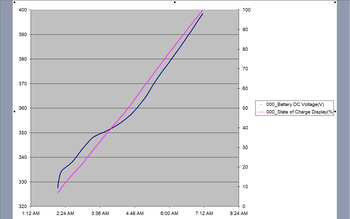
Looking at the values for Cumulative Energy Charged (CEC) - 27.6kWh were added to the battery.
This gives 27.6/0.93 = 29.7kWh usable capacity.
Looking at the values for Cumulative Current Charged (CCC) - 76.4Ah were added to the battery.
This gives 76.4/0.93 = 82.15Ah. (does this represent the usable capacity?)
This is slightly higher than the nominal capacity of 80Ah
---------------------------------------------------------
Looking at the laboratory analysis of a 2015 Soul EV battery pack, I have a couple of doubts about my analysis above.
See AVT: Battery Pack Laboratory Testing Results
1/ Once the battery gets below about 320V the drop in voltage is no longer linear.
I am assuming above that the lowest 7% of the battery will continue to drain linearly as before. It seems the BMS assumes this too. It may not be true. Perhaps a battery calibration should be done first before a range test.
2/ The measured capacity depends on the C rate. In this graph it is C/3. It may not be the same under other conditions.
In my test charging to 93% SOC took 5 hours, so the C rate is between C/5 and C/6.
This chart shows how the measured capacity of the 40Ah E400 cell varies with different constant current discharge.
From FY2014_APR_Energy_Storage_R&D (for SK Innovation E400 see printed pages 47-49, on screen pages 95-97)
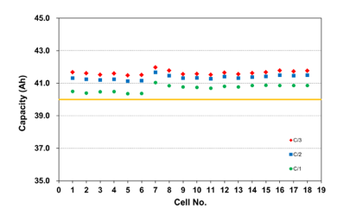
3/ The measured capacity depends on the temperature rate. For lab testing it is 23C +/- 2C. It may not be the same under other temperatures.
In my recent test the battery temperature ranged about 18C +/- 2C. I think I would get a higher capacity with hotter ambient temperatures.
-
Here is a 28.8A charge from 7% SOC to 100% SOC.
(The input to the OBC averaged 28.7A, 216.4V over 5 hours. Both stay fairly constant throughout.)
(The output from the OBC varies as the battery voltage increases. Voltage goes up, current goes down.)
(The ratio of input power / output power = efficiency was about 89%)
The initial voltage at 7% SOC is 327.4V
The final resting voltage at 100% SOC is 397.8V (each cell at 4.14V)
Cell voltage deviation was zero at all times except for the very lowest SOC when it reached 0.04V

Looking at the values for Cumulative Energy Charged (CEC) - 27.6kWh were added to the battery.
This gives 27.6/0.93 = 29.7kWh usable capacity.
Looking at the values for Cumulative Current Charged (CCC) - 76.4Ah were added to the battery.
This gives 76.4/0.93 = 82.15Ah. (does this represent the usable capacity?)
This is slightly higher than the nominal capacity of 80Ah
---------------------------------------------------------
Looking at the laboratory analysis of a 2015 Soul EV battery pack, I have a couple of doubts about my analysis above.
See AVT: Battery Pack Laboratory Testing Results
1/ Once the battery gets below about 320V the drop in voltage is no longer linear.
I am assuming above that the lowest 7% of the battery will continue to drain linearly as before. It seems the BMS assumes this too. It may not be true. Perhaps a battery calibration should be done first before a range test.
2/ The measured capacity depends on the C rate. In this graph it is C/3. It may not be the same under other conditions.
In my test charging to 93% SOC took 5 hours, so the C rate is between C/5 and C/6.
This chart shows how the measured capacity of the 40Ah E400 cell varies with different constant current discharge.
From FY2014_APR_Energy_Storage_R&D (for SK Innovation E400 see printed pages 47-49, on screen pages 95-97)

3/ The measured capacity depends on the temperature rate. For lab testing it is 23C +/- 2C. It may not be the same under other temperatures.
In my recent test the battery temperature ranged about 18C +/- 2C. I think I would get a higher capacity with hotter ambient temperatures.
-
Those are some truly impressive numbers. 
FYI. My battery was replaced (well, the cell packs were swapped out) last August. Since then I've only put on approx. 6,000km of mileage, usually charging using Type 1 to 80% max.
Last night I did an uninterrupted charge from 7% to 100% to reset the SOH, and let the car balance the cells, etc.
Once completed the car reported all cells at 41.6v, outside temperature was about 11c. Battery SOH is 99.7%, though estimate range was only 120km (lower efficiency with cooler temps and heaters running, etc. I guess).
FYI. My battery was replaced (well, the cell packs were swapped out) last August. Since then I've only put on approx. 6,000km of mileage, usually charging using Type 1 to 80% max.
Last night I did an uninterrupted charge from 7% to 100% to reset the SOH, and let the car balance the cells, etc.
Once completed the car reported all cells at 41.6v, outside temperature was about 11c. Battery SOH is 99.7%, though estimate range was only 120km (lower efficiency with cooler temps and heaters running, etc. I guess).
YpinEV
Member
Got new battery this week (37510-E4250R) on my 2016. So far all is perfectly fine and it seems to show larger autonomy than original 27kWh. After "Googling" part number, i noticed remanufacture battery packs are now offered from KIA at $1600 usd.
https://www.kia.parts/oem-parts/kia-remanufactured-pack-assembly-batt-37510e4250r
Since battery size is larger and price is reasonable compare to new one (around 12k$), I just woundering what was changed when remanufactured. Replaced some of 8 cell blocks with new ones since overall battery capacity increased?
If new battery last at least another 5 years, I would surely consider get another one then, considering it cost me almost nothing for maintenance and so little for "fuel".
https://www.kia.parts/oem-parts/kia-remanufactured-pack-assembly-batt-37510e4250r
Since battery size is larger and price is reasonable compare to new one (around 12k$), I just woundering what was changed when remanufactured. Replaced some of 8 cell blocks with new ones since overall battery capacity increased?
If new battery last at least another 5 years, I would surely consider get another one then, considering it cost me almost nothing for maintenance and so little for "fuel".
Great. Glad you got a new battery.YpinEV said:Got new battery this week (37510-E4250R) on my 2016...
Edit - Corrected my mistake - E4250R is 96 cells not 100.
If your car is a 2016 originally sold in Canada then your previous pack was a 27kWh 96 cell pack with battery heater. (37510-E4050)
Your recently installed pack is a 96 cell pack with battery heater which has the newer battery cell chemistry. (37510-E4250R)
But the R code at the end of the serial number suggests that this is not a brand new pack.
The price of the pack you link to is much cheaper than for a new pack.
It is a re-manufactured pack. They may have taken cells from an old pack from a crashed or failed MY2018 30kWh Soul EV and refurbished it.
The cells in this pack are probably 2 or 3 years old already.
This is probably okay because all the data we have so far is that these packs are holding up really well.
Will be interesting to hear again how your pack is doing in 3 or 4 years time.
YpinEV
Member
From reading with Torque and Soul EV Spy, it shows 96*2 cells managed by BMS. Total voltage also indicate total of 96 groupss. My guess is my car will only use 96 out of available 100, with likely intermediate pack connection (4 not used at all). It would do the math since dealer service department confirm it was mention 28,8kWh on crate (30kWh*96/100). It would also make sense for KIA to have one spare part to fit 2015 to 2019 models.
I will track battery degradation over next months/years and share results. I like the car and i think it will
make very good second car for next 10 years. Time will tell.
I will track battery degradation over next months/years and share results. I like the car and i think it will
make very good second car for next 10 years. Time will tell.
YpinEV said:From reading with Torque and Soul EV Spy, it shows 96*2 cells managed by BMS. Total voltage also indicate total of 96 groupss. My guess is my car will only use 96 out of available 100, with likely intermediate pack connection (4 not used at all). It would do the math since dealer service department confirm it was mention 28,8kWh on crate (30kWh*96/100). It would also make sense for KIA to have one spare part to fit 2015 to 2019 models.
I will track battery degradation over next months/years and share results. I like the car and i think it will
make very good second car for next 10 years. Time will tell.
I know that our cars have 96 cell pairs in series. You are correct to talk of 96 groups. But I prefer to simplify to 96 cells because that is the terminology that is used by Kia to talk about cell voltages and cell deterioration.
I was wrong to state that they had given you a 30kWh battery with 100 cells. I have edited my previous post.
Your recently installed pack is a 96 cell pack with battery heater which has the newer battery cell chemistry. (37510-E4250R)
Although when looking at the Kia parts website - Kia Soul EV Battery (37510-E4250)
This battery costs $12,293.25 and fits all models both 27kWh and 30kWh
I am sceptical about the accuracy of the capacity written on your pack 28.8kWh. (It is unlikely that a refurbished pack would have a mathematically exact number, and that every one of these packs would be the same). I was also sceptical when my service tech told me that my new battery was 30kWh. The whole point of this thread is my attempts to work out what the actual capacity is.
-------------------------------------------
Do you know if they put the new cells into your original case.
You can see the sticker by looking under the back of the car.
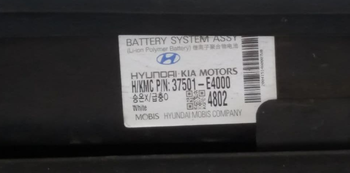
What is your range? How does this compare to when the car was brand new?
Here's my latest GOM range. The best so far after 18 months with the new battery.

-
YpinEV
Member
Do you know if they put the new cells into your original case.
You can see the sticker by looking under the back of the car.
Sticker on my pack indicate P/N 37501-4050. With dirt on it, it was original one (from 2016).
Actually in Canada/Quebec, they reuse case and exchange 8 battery blocks and change bolts and cover gasket. It takes about 4 hours for service. Big question is what cells areinstalled. From several technical sources it is nominal 28,8 kWh. I agree with you that used cells would show less capacity with aging and remanufactured set would be less than that.
What is your range? How does this compare to when the car was brand new?
Here's my latest GOM range. The best so far after 18 months with the new battery.
Wow, 216 km on GOM is impressive. Only few charging cycles on mine and it is already better than on original one. I now have 185km and i believe best i got then was around 175km. I wait for few charges for BMS to reset and get degradation values to tell me more about batterry pack condition.
You can see the sticker by looking under the back of the car.
Sticker on my pack indicate P/N 37501-4050. With dirt on it, it was original one (from 2016).
Actually in Canada/Quebec, they reuse case and exchange 8 battery blocks and change bolts and cover gasket. It takes about 4 hours for service. Big question is what cells areinstalled. From several technical sources it is nominal 28,8 kWh. I agree with you that used cells would show less capacity with aging and remanufactured set would be less than that.
What is your range? How does this compare to when the car was brand new?
Here's my latest GOM range. The best so far after 18 months with the new battery.
Wow, 216 km on GOM is impressive. Only few charging cycles on mine and it is already better than on original one. I now have 185km and i believe best i got then was around 175km. I wait for few charges for BMS to reset and get degradation values to tell me more about batterry pack condition.
I had mine in to the dealer recently for some other work. I'm still on the original battery but part of the work included a BMS update. I just got it to recharge and recalibrate today the updates and I'm seeing a similar range improvement.
After the recalibration it showed max deterioration of 17% for 93% SoH (at 72,000km), and a range of 178km. I've never seen a range like that before, max used to be 150km before it learnt the battery and once it learnt it then less.
I did notice that it was reporting actual charge level of 95% when fully charged, I wonder if the latest BMS versions allow it to use more of the actual total battery capacity?
After the recalibration it showed max deterioration of 17% for 93% SoH (at 72,000km), and a range of 178km. I've never seen a range like that before, max used to be 150km before it learnt the battery and once it learnt it then less.
I did notice that it was reporting actual charge level of 95% when fully charged, I wonder if the latest BMS versions allow it to use more of the actual total battery capacity?
IanL
Well-known member
notfred said:...
I did notice that it was reporting actual charge level of 95% when fully charged, I wonder if the latest BMS versions allow it to use more of the actual total battery capacity?
Is that charge level the SOC on the dashboard, or a value from SoulEV Spy?
-
The BMS in cars with replacement batteries that have the updated cells is significantly altered.
AFAIK the recent BMS update to cars with the original battery is not.
(And yes I know I they messed up the heat pump with a badly written update.)
Can you all check the value shown in Torque for the battery heater. Given you all have a battery heater this should be showing ambient temp.
The BMS in cars with replacement batteries that have the updated cells is significantly altered.
AFAIK the recent BMS update to cars with the original battery is not.
(And yes I know I they messed up the heat pump with a badly written update.)
Can you all check the value shown in Torque for the battery heater. Given you all have a battery heater this should be showing ambient temp.
YpinEV
Member
notfred said:I had mine in to the dealer recently for some other work. ...
Following BMS undate on my 2016, (before battery replacement) few charging cycles were required for GOM to show real life.
Do you see increase in range? (driven not on GOM) with new BMS.
I noticed slower charging current on level 2 (over 90%). That was preventing overvoltage condition on weeker cells and extend charging on other cells. I believe it was adding few extra km but nothing very significant.
Hello, this seems like the best thread to ask this question:
Is the BMS firmware different for the different battery chemistries? My '16 Kia Soul EV recently got a 37510-E4200R battery replacement. I noticed that the SOH still reads 68.4%, same as when I brought it in. I assumed that they would need to update the BMS firmware to handle the new chemistry, and that doing so would reset the SOH back to 100 (or 110?) percent.
With the new battery, the GOM displays 77 miles on full charge, whereas it was displaying 56 miles on full charge when I brought it in.
EDIT: forgot to mention that I have not been able to do a full charge cycle on it yet (down below 10% and back up to 100% charge).
Is the BMS firmware different for the different battery chemistries? My '16 Kia Soul EV recently got a 37510-E4200R battery replacement. I noticed that the SOH still reads 68.4%, same as when I brought it in. I assumed that they would need to update the BMS firmware to handle the new chemistry, and that doing so would reset the SOH back to 100 (or 110?) percent.
With the new battery, the GOM displays 77 miles on full charge, whereas it was displaying 56 miles on full charge when I brought it in.
EDIT: forgot to mention that I have not been able to do a full charge cycle on it yet (down below 10% and back up to 100% charge).
Similar threads
- Replies
- 2
- Views
- 381
- Replies
- 0
- Views
- 314
- Replies
- 2
- Views
- 443










